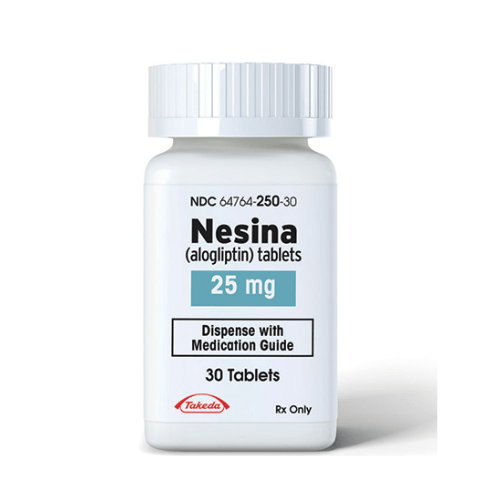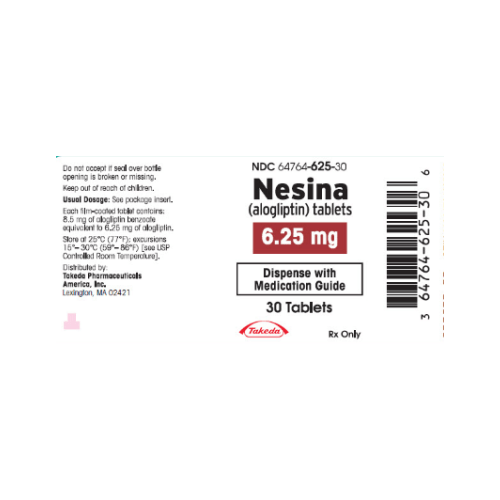Please note: a valid prescription is required for all prescription medication.
Nesina® Tablets for Type 2 Diabetes
Sitewide Super Sale - Get 15% off when you buy 3 or more of the same product using the code LESS15 at checkout.
Applies to all products originating from Canada. Maximum quantity limited to a 90-day supply per order.
Price range: $81.99 through $84.99
You save


Nesina is alogliptin, a DPP-4 inhibitor used with diet and exercise to manage type 2 diabetes in adults. This page explains how it works, key safety points, and ways to order with Ships from Canada to US options. Nesina® cost without insurance may be lower through CanadianInsulin.
What Nesina Is and How It Works
Nesina Alogliptin belongs to the DPP-4 inhibitor class, which helps your body raise incretin levels. Incretins support glucose-dependent insulin release and reduce glucagon, helping lower blood glucose after meals. This medicine is used as an adjunct to diet and exercise and can be paired with other agents when needed. It is not for type 1 diabetes or for treating diabetic ketoacidosis.
CanadianInsulin.com is a prescription referral platform. We verify prescriptions with your prescriber when required, and licensed Canadian pharmacies dispense your order.
DPP-4 inhibitors generally have a low risk of hypoglycemia when used alone. The risk can increase when used with insulin or sulfonylureas. If you take other diabetes medicines, review the official label and speak with your clinician before changes. For background on this drug class, see our overview in DPP-4 Inhibitors.
Who It’s For
This treatment is indicated to improve glycemic control in adults with type 2 diabetes. It may be used as monotherapy or with other agents such as metformin, SGLT2 inhibitors, thiazolidinediones, or insulin, as directed by your prescriber. It is not approved for pediatric use.
Avoid use if you have a history of serious hypersensitivity to alogliptin. Use caution if you have a history of pancreatitis or heart failure. People with significant kidney impairment may require a lower daily dose prescribed by a clinician. Learn more about the condition at Type 2 Diabetes, and about a common backbone therapy at Metformin.
Dosage and Usage
The usual regimen is one tablet by mouth once daily, with or without food. Swallow tablets whole with water. Take it at the same time each day to support consistency. If you have reduced kidney function, your prescriber may specify a different daily amount.
This medicine can be used as a single agent or combined with other therapies. When used with a sulfonylurea or insulin, your clinician may adjust those agents to reduce low blood sugar risk. Read the full prescribing information for complete instructions. If directions differ from this summary, follow your prescribed plan.
Strengths and Forms
Film-coated oral tablets are commonly available in these strengths:
- 6.25 mg
- 12.5 mg
- 25 mg
Availability and pack sizes may vary by pharmacy. Discuss which tablet strength fits your prescription. If you need to compare options, some patients search for Alogliptin 25 mg buy to review availability across strengths.
Missed Dose and Timing
If you miss a dose, take it when you remember unless it is near the time for your next scheduled dose. If it is close to the next dose, skip the missed dose and resume your regular schedule. Do not take two doses at once.
Keeping a daily reminder can help maintain steady use. If you frequently forget doses, talk with your clinician about routines or tools that can support adherence.
Storage and Travel Basics
Store tablets at room temperature in the original container, away from moisture and excessive heat. Keep the bottle tightly closed and out of reach of children and pets. Do not store in a bathroom or other humid areas.
When traveling, carry the medication in your hand luggage in the labeled pharmacy container. Bring a copy of your prescription and a medication list. Keep tablets away from direct sunlight or a hot car interior. If your regimen includes devices or other glucose-lowering medicines, pack backup supplies and confirm any travel restrictions in advance.
Benefits
This DPP-4 inhibitor is once daily and can be taken with or without food. It can be combined with first-line therapies for broader glucose control, as guided by your clinician. The class is generally weight neutral.
For those using metformin, a fixed-dose combination such as Kazano may be considered when appropriate. Discuss whether a single-tablet combination could simplify your routine.
Side Effects and Safety
Common side effects can include:
- Headache or dizziness
- Nasopharyngitis or sore throat
- Upper respiratory tract symptoms
- Gastrointestinal discomfort
Serious but less common risks include pancreatitis, heart failure, severe joint pain, bullous pemphigoid, liver injury, and serious hypersensitivity reactions (including anaphylaxis, angioedema, or Stevens-Johnson syndrome). Stop the medicine and seek medical attention if you develop severe abdominal pain that may radiate to the back, significant shortness of breath or swelling, rash or blistering, jaundice, or symptoms of an allergic reaction. The risk of hypoglycemia increases when this treatment is combined with insulin or sulfonylureas.
Drug Interactions and Cautions
Alogliptin has relatively few clinically significant drug-drug interactions. However, taking it with insulin or insulin secretagogues can raise the risk of low blood sugar. Alcohol can also affect glucose control and may increase side effects.
Tell your clinician about all medicines and supplements you take, including over-the-counter products. Report any history of pancreatitis, heart failure, liver disease, or kidney disease. Review class details at DPP-4 Inhibitors before starting a new therapy.
What to Expect Over Time
With regular use, you may see gradual improvements in fasting and post-meal glucose as part of your overall plan. Results depend on meal patterns, activity, and whether other medications are used. Continuous glucose monitoring or regular fingerstick checks can help track trends.
Follow up with your care team to review progress, lab results, and any side effects. If goals are not met, your prescriber may adjust the regimen or add another agent. For more on expectations with this class, see What to Expect and our broader class guide, Drug Class Guide.
Compare With Alternatives
Other DPP-4 inhibitors may be used for similar indications. Januvia contains sitagliptin and is also once daily. Onglyza contains saxagliptin and is another option your prescriber may consider based on your health history.
Pricing and Access
Canadian pricing with US shipping from Canada can offer meaningful savings compared to typical local cash costs. You can review options, compare formulations, and place an order from home. Check current Alogliptin price details on the product page.
Cost support may include card-based savings or site promotions when available. If you are seeking extra value, look for an Alogliptin coupon on our site. For general seasonal offers, visit our Promotions page. Payment methods and fulfillment steps are shown at checkout.
Availability and Substitutions
Stock can vary by strength and pack size. If the requested item is unavailable, your prescriber may recommend an alternative in the same class or a different class. Pharmacists may also contact you about clinically appropriate options to discuss with your clinician.
If you need to place an order for a refill or strength change, you can order Alogliptin after your prescriber confirms the correct tablet strength. When switching therapies, always follow clinical guidance and the official label.
Patient Suitability and Cost-Saving Tips
Adults with type 2 diabetes who need additional glycemic control may be candidates. It may suit people who prefer once-daily oral therapy and those seeking weight-neutral options. It is not for type 1 diabetes or for people with known hypersensitivity to components.
To save on recurring costs, consider multi-month fills if your prescription allows. Align refill reminders with upcoming travel and lab visits. Ask your clinician whether a class alternative or a generic alogliptin option could fit your plan. Consolidating items in one order may reduce fees. If combination therapy is needed, a single-tablet option may simplify your routine versus separate components.
Questions to Ask Your Clinician
- Is this tablet appropriate with my kidney and liver function?
- How should I monitor for pancreatitis, heart failure, or rash?
- Could metformin or an SGLT2 inhibitor be added if needed?
- What signs of low blood sugar should I watch for with other agents?
- How long before we assess changes to my treatment plan?
Authoritative Sources
For full prescribing information, see the FDA label for alogliptin (Nesina) on DailyMed: DailyMed Nesina Prescribing Information. The manufacturer provides additional professional resources: Nesina Official Site. Health Canada product details are available in the Drug Product Database: Alogliptin (Nesina) in DPD.
Order from CanadianInsulin with prompt, express shipping and temperature-controlled handling when required. Medical disclaimer: This content is for informational purposes only and is not a substitute for professional medical advice.
Express Shipping - from $25.00
Shipping with this method takes 3-5 days
Prices:
- Dry-Packed Products $25.00
- Cold-Packed Products $35.00
Standard Shipping - $15.00
Shipping with this method takes 5-10 days
Prices:
- Dry-Packed Products $15.00
- Not available for Cold-Packed products
What is alogliptin used for?
Alogliptin is a DPP-4 inhibitor used with diet and exercise to improve glycemic control in adults with type 2 diabetes. It is not for type 1 diabetes or DKA.
How should I take this medicine?
Take one tablet by mouth once daily, with or without food, at the same time each day. Follow your prescription label and your clinician’s directions.
Can it cause low blood sugar?
On its own, risk is low. The risk increases when used with insulin or sulfonylureas. Know the signs of hypoglycemia and discuss prevention with your clinician.
What are common side effects?
Common effects include headache, nasopharyngitis, and upper respiratory tract symptoms. Serious reactions such as pancreatitis, heart failure, rash, or liver issues are rare but require urgent care.
Do I need dose changes for kidney problems?
People with reduced kidney function may need a lower daily amount. Only a clinician can determine the correct tablet strength for your situation.
Can I take it with metformin?
Yes, it is often combined with metformin if additional control is needed. Fixed-dose combinations exist; ask your clinician if that option suits you.
How should I store the tablets?
Store at room temperature in the original container, away from moisture and heat. Keep tightly closed and out of reach of children.
Rewards Program
Earn points on birthdays, product orders, reviews, friend referrals, and more! Enjoy your medication at unparalleled discounts while reaping rewards for every step you take with us.
You can read more about rewards here.
POINT VALUE
How to earn points
- 1Create an account and start earning.
- 2Earn points every time you shop or perform certain actions.
- 3Redeem points for exclusive discounts.
You Might Also Like
Related Articles
Low Income Medication Help: Steps To Reduce Prescription Costs
Key TakeawaysIf low income medication costs are forcing tough choices, focus on the “next refill” problem first.Start with your exact drug name and strengthCompare cash, insurance, and assistance pathwaysAsk about…
Zepbound storage: Keep It Safe With Clear Temperature Rules
This guide explains Zepbound storage so your medication stays effective. You will learn temperature limits, how long doses can stay unrefrigerated, travel practices, and what to do if a pen…
Zepbound and Fatigue: Practical Tips to Ease Tiredness Safely
Feeling drained after starting tirzepatide can be unsettling. Many users describe a mix of low energy, mild aches, and disrupted sleep early on. If you are navigating Zepbound and fatigue,…
Mounjaro Heart Benefits Beyond Weight Loss: What Matters
Key Takeaways Beyond weight: Heart-related effects may involve blood sugar, blood pressure, and inflammation. Evidence is evolving: Large outcome trials help clarify real-world heart risk. Heart rate can rise: Small…


